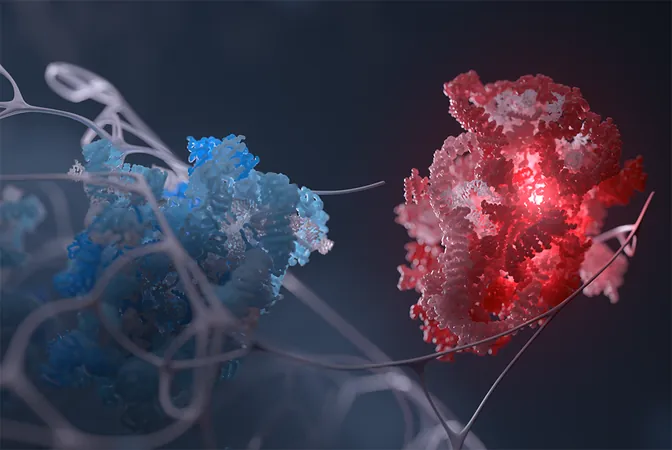
Unlocking the Secrets of Ribosome Birth: A Revolutionary Discovery from Rockefeller University
2025-07-17
Author: John Tan
A Groundbreaking Breakthrough in Cell Biology
Ribosomes, the cell's powerhouses for protein production, have long been a subject of intrigue. For years, scientists have grappled with the enigma surrounding their formation within the dense nucleolus, a cellular structure hidden deep inside the nucleus—until now. A revolutionary new study, a collaboration between the renowned Rockefeller University, Princeton University, and the Université libre de Bruxelles, has cast light on how ribosomal RNA (rRNA) plays a crucial role in giving rise to these essential molecular machines.
Peering Inside the Nucleolus
Published in the prestigious journal Nature, this pioneering research not only reveals how rRNA generates ribosomes but also demonstrates that rRNA serves as a blueprint that shapes the architecture of the nucleolus itself. Remarkably, altering this blueprint can dramatically change the nucleolus's structure, showcasing the intricate relationship between design and function within our cells.
Sebastian Klinge, head of the Laboratory of Protein and Nucleic Acid Chemistry, emphasizes the significance of this achievement: "We can now design and manipulate the architecture of an entire organelle. This brings us closer to bridging the gap between atomic structure and cellular organization—moving toward uncovering the precise molecular mechanisms that determine the shapes and functions of organelles."
The Nucleolus: The Heart of Ribosome Production
One of the earliest cellular organelles ever discovered, the nucleolus is hard to miss—it appears as a dark mass within the nucleus. This enigmatic area is where rRNA is produced, assembled, and then sent off to generate ribosomal subunits. Upon closer examination, the nucleolus is found to contain three distinct layers: the innermost fibrillar center (FC), the middle dense fibrillar component (DFC), and the outer granular component (GC).
While researchers theorized that this layered design was crucial for ribosome production, the mechanisms behind its formation and interaction with rRNA remained elusive—until now, particularly for Klinge, whose lab is dedicated to the molecular intricacies of ribosome assembly.
The Role of rRNA: A Dynamic Blueprint
Utilizing state-of-the-art techniques, the research team tracked the journey of newly synthesized rRNA within living cells, revealing that its movement indeed shapes the nucleolus. The study found that as rRNA is produced, it must traverse each layer in an exact sequence; any disruption can derail ribosome assembly, signaling that the nucleolus operates with a quality control system embedded within its structure.
This raises an exciting possibility: could the architecture of the nucleolus itself be a manifestation of the ribosome production process, dynamically sustained by it?
Engineering Synthetic Nucleoli to Test Hypotheses
To explore this intriguing hypothesis, Klinge’s lab aided in creating synthetic nucleoli to directly observe the influence of rRNA changes on nucleolar structure. By introducing specific rRNA mutations, the teams observed an inversion of the nucleolus' layers—shifting the core components to the outside and disrupting the rRNA release. This inversion could only be reverted through further mutations.
Their pioneering work lays the groundwork for a biophysical model illustrating how variations in rRNA intermediates can affect the relationship between the nucleolar layers. Klinge noted, "By redesigning a DNA plasmid previously used for functional studies, we connected pre-ribosomal rRNA sequences to the multi-layered architecture of the human nucleolus, illustrating that the correct assembly of ribosome precursors dictates its architecture."
Next Steps: Unraveling More Cellular Mysteries
These findings elevate the nucleolus from a simple ribosome staging area to a complex, RNA-driven organelle that interacts dynamically with its own assembly processes. Looking ahead, Klinge and his colleagues aim to further investigate how ribosome assembly intermediates navigate through and exit this multi-layered structure, inching closer to solving the mysteries of one of life’s fundamental building blocks. "We may soon reach a mechanistic understanding at a near-atomic level," Klinge concludes, hinting at the exciting discoveries still to come.



 Brasil (PT)
Brasil (PT)
 Canada (EN)
Canada (EN)
 Chile (ES)
Chile (ES)
 Česko (CS)
Česko (CS)
 대한민국 (KO)
대한민국 (KO)
 España (ES)
España (ES)
 France (FR)
France (FR)
 Hong Kong (EN)
Hong Kong (EN)
 Italia (IT)
Italia (IT)
 日本 (JA)
日本 (JA)
 Magyarország (HU)
Magyarország (HU)
 Norge (NO)
Norge (NO)
 Polska (PL)
Polska (PL)
 Schweiz (DE)
Schweiz (DE)
 Singapore (EN)
Singapore (EN)
 Sverige (SV)
Sverige (SV)
 Suomi (FI)
Suomi (FI)
 Türkiye (TR)
Türkiye (TR)
 الإمارات العربية المتحدة (AR)
الإمارات العربية المتحدة (AR)